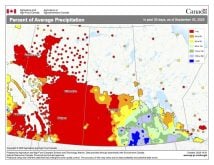Just because I wrote about hail in the last issue does not mean I caused baseball- to softball-sized hail to fall in Alberta, but talk about a weird coincidence!
Now, on to our monthly weather roundup and look ahead to what the different weather models and forecasters call for at the end of summer and the first half of fall.
I know it is a little late, but as I pointed out in the last issue, sometimes my deadlines and calendar dates do not line up.
Read Also

Farmer gift idea: How about a weather station?
The 2025 holiday season is looming, and a home weather station might make a great Christmas gift for farmers
Looking at July across southern Manitoba, most people would probably say it was an average month, temperature wise, and maybe a little wetter than average, and you know what? They would be right.
Using the three main reporting centres of Winnipeg, Brandon and Dauphin, July was remarkably similar at all locations. The mean monthly temperatures for July ranged from 19.2 C in Brandon to 20 C in Winnipeg, both a little above their long-term averages. While Winnipeg was the warm spot, Dauphin’s 19.9 C mean temperature was the warmest compared to average, coming in a little over one degree warmer.
Rainfall was also fairly uniform across the three regions, with both Winnipeg and Brandon reporting around 85 millimetres and Dauphin reporting about 80 mm. These amounts fell just a little bit above the long-term averages for July.
Moving west, using Saskatoon and Regina as the reporting stations for Saskatchewan, they too saw similar conditions to Manitoba, at least in the temperature department. Both reported mean monthly temperatures right around 19.4 C, which is about 0.5 C above their long-term averages. Precipitation in July was a little below average in Saskatoon and average in Regina.
Looking at Alberta, using Peace River, Edmonton and Calgary as the main reporting stations, we see that the warmer-than-average temperatures not only continued but intensified. Mean monthly temperatures ranged from 17.1 C in the Peace River region to 19.6 C in Edmonton, and while the temperatures were cooler overall than Saskatchewan and Manitoba, they were warmer compared to their long-term averages.
The Peace River region came in about one degree above average, Calgary about two degrees warmer, and Edmonton came in at a very warm three degrees above average for the month. Precipitation was well below average in the Edmonton and Peace River regions with both locations coming in about 40 mm below average. Calgary, thanks to a couple of thunderstorms, received average precipitation for July.
At least for Manitoba, it was a slightly warmer than average month with near- to slightly above-average precipitation. Looking back at the different forecasts, it looks like the Canadian Farmers’ Almanac did the best job with its forecast of warmer than average temperatures along with near-average precipitation. We have to remember that this is my interpretation, because their forecasts simply point out key weather events they expect to occur during the month.
As for the end of summer and early fall weather outlooks, we begin with the almanacs. The Old Farmer’s Almanac is calling for a cool and wet August and September followed by a warm October with near-average precipitation. The Canadian Farmers’ Almanac website is still glitching for me and will not allow me to access forecasts beyond a month.
For August, it appears to be calling for near-average temperatures and precipitation as it calls for heat early on and then fair conditions with the odd showery period.
Moving to computer models, the CFS model is calling for a warmer- and drier- than-average August right across the Prairies. These conditions are expected to continue into September and October, with September seeing below- average precipitation and October expected to see near-average amounts.
The CanSIPS model calls for similar conditions to CFS. Expect above-average temperatures from August through to October with below-average precipitation in August and September and near average in October.
Looking at NOAA’s three-month weather outlook, it predicts equal chances of either above- or below-average temperatures and precipitation. I usually take this as a call for near-average weather. I remind you that NOAA’s forecast stops magically at the U.S./Canadian border, so the reliability of the forecast decreases as you move north from the border.
The final model is the ECMWF (European Center for Medium-range Weather Forecasts). Along with CFS, this is the other model I use when putting together my forecasts. This model is in step with CFS and CanSIPS and is calling for above-average temperatures along with near- to below-average precipitation.
Finally, my forecast. To be honest, I can’t go against what the three main weather models predict. Hopefully, these forecasts play out as they sound — a nearly perfect ending to a rather interesting growing season across our region.
















